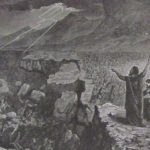We run our website the way we wished the whole internet worked: we provide high quality original content with no ads. We are funded solely by your direct support. Please consider supporting this project.
The Cruciform Center Part 1: How Matthew, Mark and Luke Reveal a Cruciform God
In the previous series of posts I’ve argued that a merely “Christocentric” approach to God is too general, as can be shown by the widely different conceptions of God people arrive at, despite their claim to be “Christocentric.” The confession that Jesus reveals what God is like is simply too abstract, for it leaves too much room for people to impose a preconceived concept of God onto him. I’ve instead argued that the NT itself gives us a much more specific criteria for understanding God when it reveals that “God is love” (I Jn 4:8) while defining “love” by pointing us to the cross (I Jn 3:16). This, I contend, is the thematic center of everything Jesus was about. So, instead of adopting a “Christocentric” approach, I submit that we ought to adopt a “crucicentric” approach. As we shall see, this more specific perspective changes everything.
The cross-centered understanding of God that I’m proposing is both new and (therefore) controversial. As such, the burden of proof is on me to demonstrate its validity. So, over the next four blogs I want to demonstrate how the centrality of the cross is reflected throughout the NT. I’ll refer to this series as “The Cruciform Center.” In Part I, which is the remainder of this blog, I’ll how the Synoptic Gospels display a cruciform center. In Part II I’ll show this with regard to the Gospel of John. Part III will demonstrate the centrality of the cross in Paul, and, finally, Part IV will show how the cross is at the center of the Book of Revelation.
To begin, scholars have frequently noted that the Synoptic Gospels are structured around the Passion narrative. The New Testament scholar Martin Kahler isn’t overstating the case when he famously declared that “…one could call the Gospels passion narratives with extended introductions.”[1] The narrative of these Gospels points forward to, and climaxes in, the revelation of Jesus on the cross. This conclusion is supported in four ways:
1. Each Gospel depicts Jesus trying to break through his disciple’s preconceived notions about the Messiah by teaching them that he had to go to Jerusalem to “suffer many things” and to be executed (Mt 16:21; 17:23; 20:19; 26:2; Mk 10:32-34; Lk 17:25; cf. 24:7).
2. As I mentioned above, the way Jesus redefined power points to a cross-centered understanding of power. He repeatedly stated that he had not come into the world to “be served, but to serve, and to give his life as a ransom for many” (Mt 20:28; Mk 10:45). This statement anticipates the kind of power revealed on the cross. Instead of self-promoting power that the devil offered in the temptation narratives (Mt 4:9; Lk 4:6), the Gospels define the power of God to be his self-sacrificial love.
3. Jesus’ commands and teachings reflect a cruciform ethic. He taught his disciples that the one who served is greater in the kingdom than the one who is served, and the last would be first and the first would be last (Mt 20:16, Mk 10:31, Lk 13:30). So too, Jesus taught that the precondition for being considered a disciple is that one must be willing to “pick up their cross and follow [him]” (Luke 9:23). And, most significantly, Jesus taught that his disciples were to love and serve people indiscriminately – like the rain falls and the sun shines, for this is how their heavenly Father loves (Mt 5:44-45; Lk 6:27-35). This is why Jesus taught that they were to love their enemies and to swear off all violence “so that [they] would be children of the Father in heaven” (Mt 5:45). He is teaching that disciples can only be considered children of the Father when they reflect his loving character, and it turns out to be the kind of character that finds its quintessential expression on the cross, when God suffered on behalf of all humans.
4. Finally, Jesus’ actions conform to his cruciform teaching. For example, the fact that Jesus dared to fellowship with those who were most harshly judged by the religion of his day and who were considered abandoned by God – the prostitutes, tax collectors and other sinners – clearly anticipates the cross, when Jesus fully entered into the God-forsakenness of all humans that results from sin.
It’s evident that for the Synoptic Gospels, Jesus’ life and teachings reflect the same character that is reflected in his self-sacrificial death. Everything Jesus was about ultimately expressed God’s enemy-embracing, self-sacrificial character. This is precisely what we should expect if Jesus reveals that “God is love,” and if love is defined by the cross. And this is why I claim that the cross functions as the thematic center of everything Jesus was about.
In the next post we’ll see that the same holds true of the Gospel of John, though it is expressed in slightly different ways.
[1] M. Kähler , The So-Called Historical Jesus and the Historic Biblical Christ, trans. C. E. Braaten (Philadelphia: Fortress, 1964 [1896]), 80, n.11.
Related Reading

Must wives submit to husbands?
The apostle Paul writes: Wives, be subject to your husbands as you are to the Lord. For the husband is the head of the wife just as Christ is the head of the church, the body of which he is the Savior. Just as the church is subject to Christ, so also wives ought to…

In light of Einstein’s conclusion that time is relative, how can you believe that God is not above time?
Relatively Theory basically stipulates that whether an event is viewed as being in the past, present or future depends on where one is in relation to the event in question as well as how fast one is moving. Some people conclude from this that Relativity Theory lends support to the classical view of God in…

Four Principles of the Cruciform Thesis
In the second volume of Crucifixion of the Warrior God, I introduce how four dimensions of the revelation of God on the cross (as introduced in this post) lead to four principles that show us how to unlock aspects of the OT’s violent divine portraits and thus disclose how a given portrait bears witness to…

That Weird Episode with the Pigs
In my opinion, the single strangest episode recounted in the Gospels is the account of Jesus’ encounter with a demonized man that ended with two thousand pigs drowning themselves in the Sea of Galilee (Mk 5:1-10//Mt 8:28-34; Lk 8:26-39). Some find it morally objectionable that this mass suicide was the result of Jesus allowing the…

The Lord of Legend and Love
However secularized a person may be, if they have any sense at all that life has a meaning, they know it must have something to do with love. Indeed, one could argue that all of our intuitions about morality and the meaning of life are at root an intuition about the supremacy of love. At…

Xmas
Kevin Dooley via Compfight Zach Hunt brings a huge challenge in this article about the ongoing lament about the “liberal attack on Christmas.” Maybe the real problem is not with the media or the “liberals” or the merchants, but with us. There’s an opportunity here for us to remember who we really are and what…

